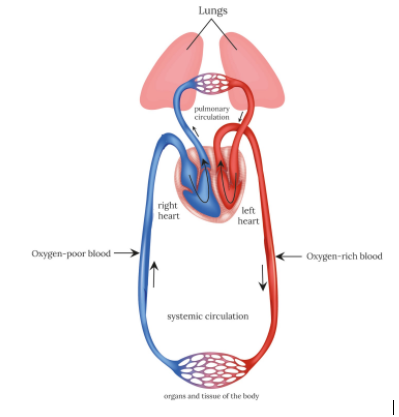
Incomplete double circulation is seen in -
(a)Fish
(b)Amphibians
(c)Birds
(d)Mammals
(e)Arthropods
Answer
563.1k+ views
Hint: - Incomplete double circulation is about a method of circulation in the body where the circulation is not complete, that is, the blood pumped from the heart to the rest of the body is not completely pure that occurs in organisms that live both in water and land. To understand this further, complete circulation occurs in birds and mammals, where pure blood is available in specific vessels only.
Complete answer:
- Incomplete double circulation is a method of pumping blood throughout the body in a closed circulatory system. Here, blood is pumped from a three-chambered heart consisting of two atria and a single ventricle.
- The blood enters the heart through two different routes but goes out through a single route. Left atrium receives oxygenated blood and deoxygenated blood is received by the right atrium. But, both the types of blood mix in the single ventricle which then pumps out the mixed blood.
- The circulation is called double circulation because of the following reason - the mixing of the blood is slightly reduced by a ridge within the ventricle that diverts the oxygen-rich blood throughout the body (systemic circuit) and the deoxygenated blood through the lungs and heart (pulmocutaneous circuit) where gas exchange occurs in the lungs and through the skin.
Additional Information: - Amphibians, reptiles, birds, and mammals have two types of circuits for blood flow - one through the lungs and back to the heart (pulmonary circulation) and the other throughout the rest of the body and all organs, including the brain (systemic circulation).
- Warm-blooded animals like mammals and birds have a more efficient system in the form of a four-chamber system (like the heart in human beings) where the oxygenated blood is completely separate from deoxygenated blood.

So, the correct answer is ‘Amphibians’.
Note: - Incomplete double circulation is also known as a mixed double circuit.
- Amphibians are unique in that they have the third circuit apart from the pulmonary and systemic circuit that brings deoxygenated blood to the skin in order for gas exchange to occur. This process is called pulmocutaneous circulation.
- Mixing of oxygenated and deoxygenated blood does not occur in some reptiles such as crocodiles.
Complete answer:
- Incomplete double circulation is a method of pumping blood throughout the body in a closed circulatory system. Here, blood is pumped from a three-chambered heart consisting of two atria and a single ventricle.
- The blood enters the heart through two different routes but goes out through a single route. Left atrium receives oxygenated blood and deoxygenated blood is received by the right atrium. But, both the types of blood mix in the single ventricle which then pumps out the mixed blood.
- The circulation is called double circulation because of the following reason - the mixing of the blood is slightly reduced by a ridge within the ventricle that diverts the oxygen-rich blood throughout the body (systemic circuit) and the deoxygenated blood through the lungs and heart (pulmocutaneous circuit) where gas exchange occurs in the lungs and through the skin.
Additional Information: - Amphibians, reptiles, birds, and mammals have two types of circuits for blood flow - one through the lungs and back to the heart (pulmonary circulation) and the other throughout the rest of the body and all organs, including the brain (systemic circulation).
- Warm-blooded animals like mammals and birds have a more efficient system in the form of a four-chamber system (like the heart in human beings) where the oxygenated blood is completely separate from deoxygenated blood.

So, the correct answer is ‘Amphibians’.
Note: - Incomplete double circulation is also known as a mixed double circuit.
- Amphibians are unique in that they have the third circuit apart from the pulmonary and systemic circuit that brings deoxygenated blood to the skin in order for gas exchange to occur. This process is called pulmocutaneous circulation.
- Mixing of oxygenated and deoxygenated blood does not occur in some reptiles such as crocodiles.
Recently Updated Pages
Master Class 12 Business Studies: Engaging Questions & Answers for Success

Master Class 12 Economics: Engaging Questions & Answers for Success

Master Class 12 English: Engaging Questions & Answers for Success

Master Class 12 Maths: Engaging Questions & Answers for Success

Master Class 12 Social Science: Engaging Questions & Answers for Success

Master Class 12 Chemistry: Engaging Questions & Answers for Success

Trending doubts
What is meant by exothermic and endothermic reactions class 11 chemistry CBSE

Which animal has three hearts class 11 biology CBSE

10 examples of friction in our daily life

One Metric ton is equal to kg A 10000 B 1000 C 100 class 11 physics CBSE

1 Quintal is equal to a 110 kg b 10 kg c 100kg d 1000 class 11 physics CBSE

Difference Between Prokaryotic Cells and Eukaryotic Cells




